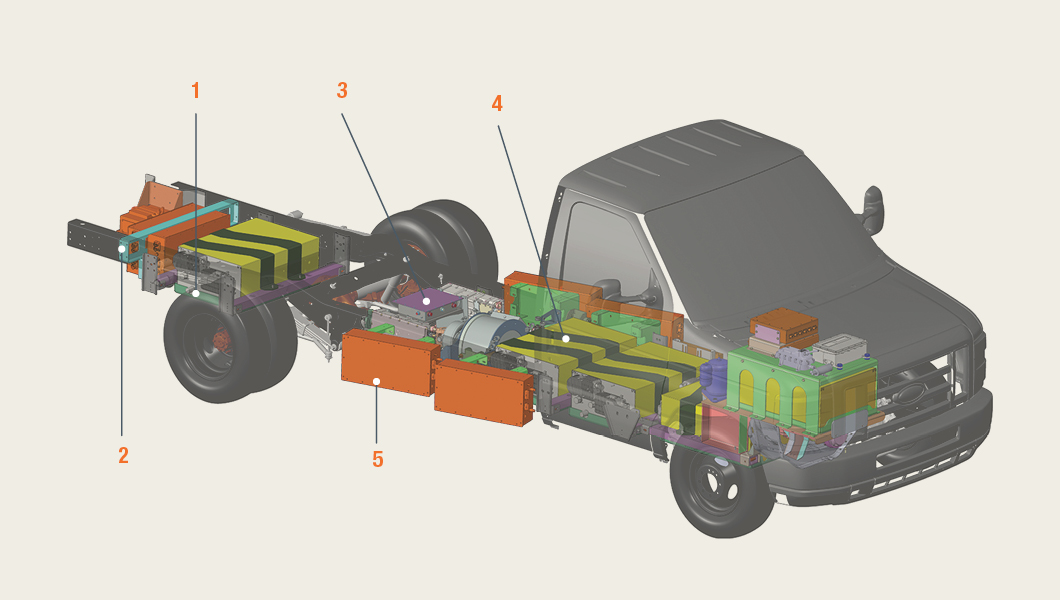Zero Reasons
The future of transportation is electric, and Motiv CEO James Castelaz ’06 is leading the way.
Just three years after graduation from Harvey Mudd College with a double major in engineering and economics, James Castelaz ’06 started a company that is now the U.S. market leader in transforming fossil fuel-guzzling trucks and buses into zero-emission electric vehicles (EVs). In 2017, the Silicon Valley Business Journal recognized Castelaz’s meteoric rise by naming him one of its “40 Under 40,” citing his leadership as founder and CEO of the 55-employee company, Motiv Power Systems, which holds six patents and five patents pending for power system innovations to enable the shift from diesel and gas to electric power.
Harvey Mudd College Magazine caught up with Castelaz at Motiv’s new headquarters in Foster City, California, to find out how he made the leap from student to successful entrepreneur in little more than a decade, and what’s new in the quickly evolving field of EVs.

HMC Magazine: Why did you focus on making buses and trucks, the so-called medium-duty vehicles, run on electricity?
Castelaz: About 80 percent of trucks and buses out there are fantastic candidates for electrification— that includes everything from school buses and shuttle buses to delivery vans and garbage trucks— because they have a set route that brings them back to the depot every night. That overcomes two of the biggest obstacles to electrification: range anxiety and charge infrastructure.
The only remaining problem was the total cost of ownership relative to a combustion vehicle, but now that battery prices have dropped dramatically over the past year, payback periods are down to about three years, and that is a huge enabler for the industry.
HMC Magazine: Motiv designed its chassis, called the electric powered intelligent chassis (EPIC), to easily replace a diesel- or gas-powered chassis. How does that work?
Castelaz: EPIC uses a proven platform—like Ford’s E450 and F59 platforms—but is an electric version of those chassis that can drop right into a truck or bus manufacturer’s assembly line and replace their gas or diesel chassis with essentially no need for re-engineering.
HMC Magazine: What role does the “intelligent” part of EPIC play in EVs?
Castelaz: Because we’re running on electricity instead of combustion, we have many more “knobs” to turn within the software. With Motiv’s EV software, we can actively manage power flow between all of the vehicle’s electrical components, and monitor and analyze vehicle data, including battery charge, to stay on top of maintenance, so we can do a lot more than we could ever do with internal-combustion vehicles. Plus, if a fleet adds an electric truck this year, they’re going to find that over that truck’s lifetime, it’s going to get better and better at doing its job in terms of efficiency and safety, because of the software updates that we will continually push to all Motiv-powered vehicles.
HMC Magazine: Can the software also “learn” how to run more efficiently for individual drivers?
Castelaz: We call that consideration management, so yes, there are things we can do with the software to make the EV more efficient based on what its job is, who’s driving it and how the driver is driving it.
HMC Magazine: Where did your interest in engineering come from?
Castelaz: My dad was an astrophysicist, and I enjoyed using a telescope we would roll out of our garage and set up on the driveway of our home in Tennessee. As I got older, I realized I liked the science as discovery, but even more, I enjoyed figuring out how to make instruments work and how to develop the tools needed for those scientific pursuits.
HMC Magazine: How did you wind up in California?
Castelaz: My uncle lived in Orange County and suggested Harvey Mudd, so I visited the College and thought this seemed like the right place for me to learn about science, math and engineering. During my time there, I had some really great summer internships, including one working for Professor Dick Haskell [Burton G. Bettingen Professor of Physics] and helping him develop an optical coherence microscope. I also did instrument development during a couple of summer internships at Lawrence Livermore National Lab, and I enjoyed that too.
HMC Magazine: How did you become an entrepreneur?
Castelaz: I realized that I liked working on these interesting engineering projects, and I began to think about pursuing my own engineering consulting practice. That led me to the conclusion that I should probably get a PhD, so I went to Stanford University, but then decided to take a leave of absence from grad school and try my hand at entrepreneurship full-time. My first try was a company that focused on electric transit buses for the Chinese market, but it didn’t work for a number of reasons. After that, in 2009, I started Motiv. I recruited some of the technical team from that original company, including a couple of my classmates from Harvey Mudd and a couple from Stanford, and began focusing on platform technology—patented battery solutions and the software program—that any truck or bus manufacturer could use to easily build electric versions of their diesel trucks and buses.
HMC Magazine: Why was electric power such a draw?
Castelaz: For me, this was an opportunity to marry what I thought I was pretty good at, which was electrical engineering, to a global problem. It was something where I could do a gut check and say, “If I dedicate my career to this, I can feel like I’m using my talents in a way that’s going to leave my world better than I found it and do it in a very concrete way that I can be excited about.”
HMC Magazine: Do you get that feeling?
Castelaz: I do. I see school districts with school buses that are using Motiv’s technology, so we are helping kids get to school without being exposed to the carcinogens that are present with combustion vehicles. As a parent myself with four kids, that’s pretty satisfying. Plus, I can look at the carbon that’s being saved by using these EVs, and I can feel good about that too.
HMC Magazine: What’s next for large-vehicle EVs, and for Motiv in particular?
Castelaz: I think EVs in general are poised to really take off over the next three to five years. There is big interest through the whole automotive world around EVs. Companies want cleaner, quieter, lower-maintenance truck and bus fleets, and now we are at this amazing inflection point in the market where we can make the economics work. At Motiv, we are in a strong growth phase, both hiring a lot and increasing production capacity. We’re actively looking for Mudd alums. I think the liberal, interdisciplinary education at Mudd is a great preparation for Motiv and the EV industry. And now we also have some interesting next- generation technology products in our pipeline to substantially decrease costs while increasing performance. For the industry and at Motiv, it’s a very exciting time.

EPIC Chassis
1. Regenerative Braking: Recaptures energy to extend range and reduces wear and tear on brake components.
2. Charger: Adaptable connector field replacement capable of supporting 25 kilowatt charging.
3. Motor: Six-phase, permanent-magnet, synchronous axial flux AC motor for powerful, smooth acceleration.
4. Battery: EPIC chassis are battery agnostic allowing for different battery technologies and chemistries. EPIC chassis also utilize automotive batteries which keep purchase and replacement costs low.
5. Adaptive Power Converter (APC): APCs keep batteries balanced and at optimal charge for long service life and great performance.

